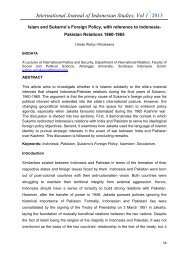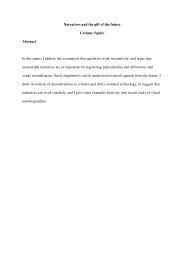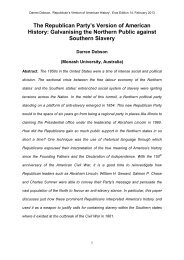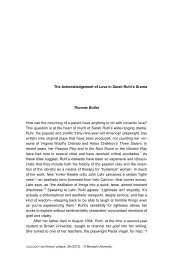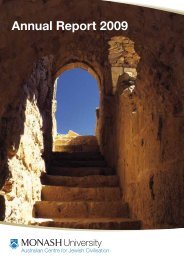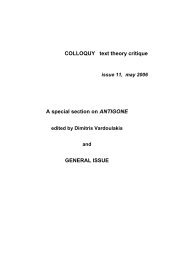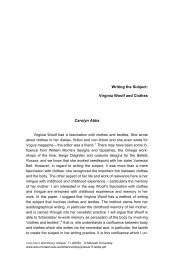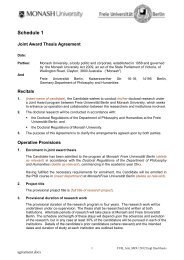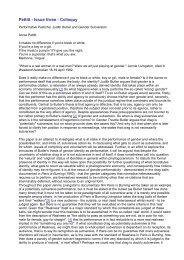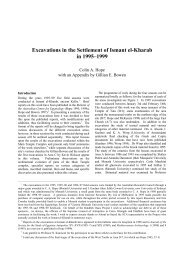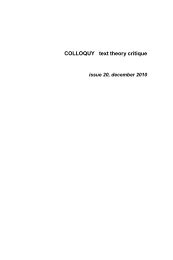Review of Louis Nowra, Bad Dreaming: - Arts - Monash University
Review of Louis Nowra, Bad Dreaming: - Arts - Monash University
Review of Louis Nowra, Bad Dreaming: - Arts - Monash University
- No tags were found...
Create successful ePaper yourself
Turn your PDF publications into a flip-book with our unique Google optimized e-Paper software.
<strong>Louis</strong> <strong>Nowra</strong>, <strong>Bad</strong> <strong>Dreaming</strong>:Aboriginal Men’s Violence against Women and Children,North Melbourne: Pluto Press, 2007. ISBN: 978-0-9802924-0-4Jay Daniel ThompsonIn <strong>Bad</strong> <strong>Dreaming</strong>, the white playwright <strong>Louis</strong> <strong>Nowra</strong> focuses on sexualabuse in Aboriginal communities. <strong>Nowra</strong> endorses the Aboriginal elderMick Dodson’s argument that this abuse is “everyone’s problem” and writesthat he hopes his book will help keep this subject “before the public” for thepurposes <strong>of</strong> discussion and debate (8). <strong>Nowra</strong>’s text is impassioned andundoubtedly well-intentioned. Unfortunately, though, it is also imbued with adistinctly Anglocentric attitude towards the issue it explores.In the opening page, <strong>Nowra</strong> relays one <strong>of</strong> the experiences thatprompted him to write this book. He recalls how, while staying in an AliceSprings hospital, he met an Aboriginal man “who was quite proud that hehad raped a thirteen year old girl” (1). In the pages that follow, <strong>Nowra</strong> describesvarious other acts <strong>of</strong> sexual violence that Aboriginal women andchildren have experienced at the hands <strong>of</strong> Aboriginal men. The writer alsodescribes how this abuse has been silenced by Aboriginal “cultural traditions”(7), as well as by white men and women who have considered thatreporting sexual violence in Aboriginal communities might be a racist act initself. <strong>Nowra</strong> concludes his text by considering some ways <strong>of</strong> “helping (Aboriginal)women and children” escape this violence (89).<strong>Nowra</strong> has done some broad-ranging research into his chosen topic.His bibliography lists a range <strong>of</strong> academic texts, media articles and reportssuch as Breaking the Silence by The Aboriginal Child Sexual Assault Taskforce.However, <strong>Nowra</strong> seldom cites these references throughout the body<strong>of</strong> his book. His failure to do this proves to be a particular problem when theCOLLOQUY text theory critique 13 (2007). © <strong>Monash</strong> <strong>University</strong>.www.colloquy.monash.edu.au/issue13/nowra.pdf
░ <strong>Bad</strong> <strong>Dreaming</strong> 169author makes such broad statements as: “…Aboriginal children knew moreabout sexuality at a much younger age than their Western counterparts”(29). Reading statements such as this, one is led to wonder whether theauthor has substituted speculation for facts. (And I might note here <strong>Nowra</strong>’sincorrect use <strong>of</strong> the word ‘Western’ – the terms ‘Anglo-Saxon’ or even‘white’ would be more accurate.)However, my greatest concern with <strong>Bad</strong> <strong>Dreaming</strong> is the pessimisticand patronising attitude the author frequently displays towards Aboriginalcommunities. I do not deny that <strong>Nowra</strong> is genuinely outraged and saddenedby the prevalence <strong>of</strong> sexual violence in these communities. Yet Ifound the book's overall suggestion – that Aboriginal men and women aremostly unwilling to stop this violence – to be quite disturbing. <strong>Nowra</strong> is particularlycritical <strong>of</strong> the indifference that Aboriginal men supposedly have towardsrape and, in fact, any problem facing Aboriginal communities. Hemakes this clear in passages such as the following:(Aboriginal) men not only have to realise that their behaviour is underminingAboriginal culture but that they are creating a generation<strong>of</strong> boys without good role models – whether through their terriblebehaviour, that they are in prison much <strong>of</strong> the time, or are constantlydrunk and stoned … Men must be taught that their behaviour towardswomen is wrong, just as is happening in non-indigenous Australia.(91)In contrast, it is “non-Indigenous” men and women who appear to be mostconcerned with sexual violence, poverty and substance abuse amongstmembers <strong>of</strong> Australia’s Aboriginal population. Early in the text, <strong>Nowra</strong>writes that “traditional Aboriginal sexual practices” – in which he includesrape, child sexual abuse and incest – have “appalled many whites” (28).There is scant reference to the sexual abuse (and other myriad forms <strong>of</strong>violence) that Aboriginal women, children and men have experienced at thehands <strong>of</strong> white men and women. Elsewhere, he observes that “overseasvisitors” to this country have been “shocked” by what they have witnessedin many Aboriginal communities (37). This latter observation is particularlydubious: <strong>Nowra</strong> seems to be suggesting that many <strong>of</strong> the problems facingAboriginal people are problems because they pose a potential threat toAustralia’s tourist industry.Conversely, <strong>Nowra</strong>’s remarks about white men and women who haveavoided speaking out about sexual violence in Aboriginal communities arealso imbued with racism. He is certainly correct to point out that, throughoutAustralian history, many politicians and members <strong>of</strong> “progressive” socialmovements have <strong>of</strong>ten ignored Aboriginal concerns (33). However, <strong>Nowra</strong>
170<strong>Louis</strong> <strong>Nowra</strong>░then criticises an article by gender studies academic Elspeth Probyn inwhich shewrote that the abuse in Aboriginal communities is supposedly rife yetwas horrified that children would be removed from their families,even though it would be to protect them from a grim situation. Ideologyhas taken precedence over revealing the ghastly facts <strong>of</strong> what ishappening to indigenous women, boys and girls (33-4).<strong>Nowra</strong> appears to be implying here that the removal <strong>of</strong> Aboriginal childrenfrom their families was always done in the best interest <strong>of</strong> these children.Such an implication fits in perfectly with the kind <strong>of</strong> historically naïve andwhite supremacist rhetoric that has long been expounded by conservativefigures such as Pauline Hanson. And, like these conservatives, <strong>Nowra</strong> dismisseswould-be critics <strong>of</strong> his argument by suggesting that they are blindedby “ideology.”At this point, I should disclose my own racialised and gendered subjectposition. I am (like <strong>Nowra</strong>) a white male. Also, I agree that the issue <strong>of</strong> sexualviolence in Aboriginal communities is one that should be <strong>of</strong> concern tothe Australian community as a whole (as well as, dare I say it, “overseasvisitors”). However, I do not believe that one can work towards overcomingsexual violence amongst Aboriginal Australians by arguing that they “can’teven govern themselves” (84). Such an argument only fuels stereotypes <strong>of</strong>Aboriginal people as uncivilised, inherently destructive (and selfdestructive)and in need <strong>of</strong> taming by white men and women. These stereotypeswill not help build allegiances between Aboriginal and non-Aboriginalpeople, and they certainly will not help achieve justice for Aborigines.In conclusion, <strong>Bad</strong> <strong>Dreaming</strong> will possibly help to increase media attentionon the issue <strong>of</strong> sexual violence in Aboriginal communities. A recentarticle on the book that was published in Melbourne’s Age newspaperseems to confirm this. However, it is hoped that in the future, more mediaattention will also be given to Aboriginal men and women who are workingto eliminate sexual violence in their communities.<strong>University</strong> <strong>of</strong> Melbournej.thompson4@pgrad.unimelb.edu.au



